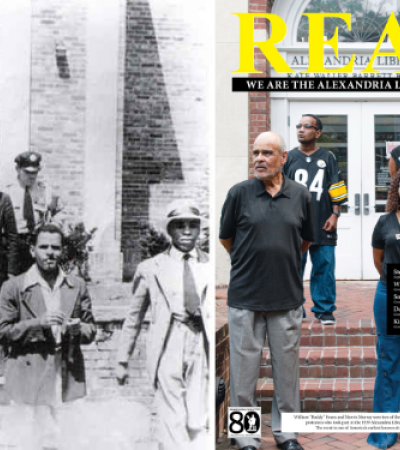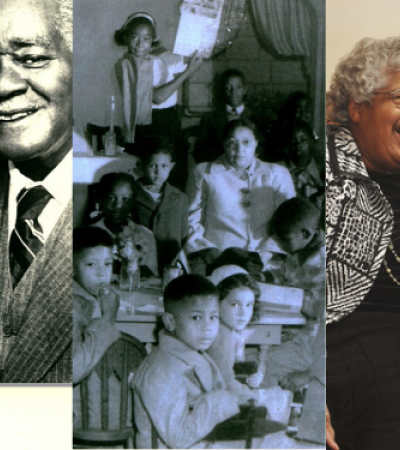For the past four years, Monique Sugimoto has commuted to her job at the Palos Verdes Library District on an electric bike — a scenic ride along the cliffs in her coastal California town. As she rode, her librarian brain was hard at work.
“When I came across historic locations, I would devise these little tours in my head,” Sugimoto says. “When the pandemic struck, I thought, how great would it be if I could bring these tours out of my head and into people’s homes?” And that is exactly what she did.
Sugimoto posted the first Pedal PV video in September 2020. Since then, she has produced five videos to share local history via bike. She hopes the videos — created in a style she calls “Huell Howser meets Tik Tok” — inspire a younger generation.
I spoke to Sugimoto about what she’s learning about being a vlogger and how the pandemic has changed her work as an archivist at the library.
How did your video series get started?
Since the pandemic, one of the things that I miss so much is people coming to work and discovering history at our local history center. I have lived on the peninsula since 1998, and I’m still so amazed by its beauty and history, and I love to share it with others.
Frederick Law Olmsted Jr. laid out the Palos Verdes Peninsula 100 years ago. One of the key features of Olmsted’s designs — his father designed Central Park — was that houses and roads should all fit within the contour of the land. When you’re on a bike, you get the unique experience of seeing how the roads curve along the peninsula how Olmsted intended.
I've given presentations on local history before, but never had I thought of making them into short videos. I didn’t even know what a vlog was before this! I started learning the ropes. I worked with StoryCenter on a digital storytelling workshop for our community and was amazed by the power of storytelling and had that in mind. For the nuts and bolts of vlogging, I took a course on LinkedIn.
What equipment do you use?
My iPhone 11 is my best friend. I use it to take the videos and sometimes to record the narration. My “kit” includes the DJI Osmo 3, RØDE VideoMic Me — this includes a windsock to cut down on noise — and a USB flash drive to transfer video from my phone to my computer. I also have a handlebar mount made by SKYJFFJ to hold the Osmo so I can shoot on my own.
For the videos so far, my husband has been the videographer; he follows behind recording the footage. To cut the videos together, I use the online editing tool, WeVideo.
What have you learned since starting these videos back in September?
I’ve learned so much about technology. With this new equipment and video editing, it was all new to me. But also using my cell phone is different ways. It's been a learning curve.
When I first started, I wasn’t sure what to do first: write the script or record the footage. Now I get a rough script and topic in mind, and I find photos from the archives that I can marry with the footage. Sometimes I don’t know the story until I get the footage, or I think of a topic and go out to film and the topic completely changes.
I originally set out to do a video every two weeks, but now I’m trying to do an episode every three weeks. Not being in the building every day has limited my research time. Perhaps the most important lesson. though. is the craft of storytelling and how to use visuals to tell a story. There is so much to learn here.
How did you get used to the logistics of filming, biking and pointing out your destinations?
Before we go out, my husband and I talk about what shots we need and come up with a bike route. (We usually have a lunch stop along the way.) The first bike ride was long! Luckily, my husband and I use electric bikes so that helps with any uphill climbs.
We have also learned how to keep up with each other. My husband’s bike, we learned, is a bit slower than mine, so we have to adjust speeds. Because he films and bikes, he can run into some bumps that throw off the camera orientation, but we’ve definitely gotten the logistics down a lot better since our first ride. After we’re done I review the video and upload the footage into WeVideo.
What is your favorite place that you have visited in the series?
In the Cliffs and Recreation video, we start out in the Douglas Cut, where the road was blown up in order to create the new road. This is a spot to reflect and see how Olmsted developed the area. It’s also just a beautiful view and one I see every day.
Any plans to keep this up after the pandemic?
I would like to continue doing it because it makes history so much more accessible. We get a lot of views. Recently, community members have asked for videos on specific topics, so I’d like to respond to those.
I might switch up the format a bit by having people come along with me for interviews. Now, during the pandemic, there is a freedom in experimenting with new things because if it doesn’t work out, oh well!
I’m ridiculously fortunate to be able to document the history of my own community. How lucky is that?
Finally, why is this program important right now?
I think it's important to keep the connection with our community, and these videos are one way to do that. When the library building shut down, we were no longer the community’s living room, so it was important to re-create that in a virtual space.
The videos are also inspiring people to look through their own old photos and documents. The idea of the videos as a launching point for conversation is really fantastic and something that I hope continues.
Of course, this has been a tough time for a lot of people in and out of our community. I try to keep the videos light, so it creates a connection to our history. If it keeps people entertained during these hard times, that is successful to me.
Funding for this article series has been provided by the National Endowment for the Humanities (NEH) as part of Coronavirus Aid, Relief and Economic Security (CARES) Act economic stabilization plan.




